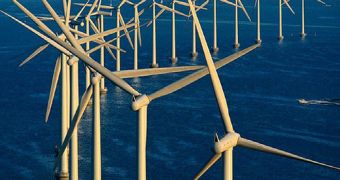Wind power was considered for a long time as inconsistent as the wind itself, but the need for alternative non-pollutant power source and mankind's dependence on electrical energy pushes scientists to find new solutions to the problem for intermittent winds. Scientists in the U.S. propose that the wind farms disposed in different geographical areas could be harnessed energy more efficiently if they were interconnected with the help of transmission lines.
The wind power could offer potentially large amounts of cheap electric energy. But the problems most wind farms encounter are related to the fact that wind does not blow continuously, but in certain time interval, thus the power produced this way cannot provide the baseload of electric power. The baseload of electric power represents the amount of steady and reliable electric power, which must be available at all time and is generally produced with the help of power plants burning fossil fuels, or with the help of nuclear power plants.
Interconnecting all the wind farms would resolve the problem of providing steady, reliable electric power, caused by wind variability and could reduce significantly the amount of energy produced by coal burning power plants, thus reducing the amounts of greenhouse gases dumped in Earth's atmosphere.
According to the study conducted by Cristina Archer and Mark Jacobson, more of a third of the energy produced by interconnected wind farms would provide a reliable power source. The idea implies that linking wind farms situated at different locations would resolve the differences of output of power between regions where winds are calmer and the regions where they would be gustier. Nevertheless, not all locations can provide strong enough winds so that electric energy is being efficiently produced.
The other advantage, that of interconnecting individual wind farms would be that the distance which the power has to travel from multiple origin points can be shortened by connecting the individual wind farms to a single common destination point, from which the energy will be sent over long distances to cities, thus reducing the costs related to the transmission of energy, by reducing the power loss through long-distance lines.
Archer believes that reducing the long-distance capacity transmission will result in a decrease in power delivery of 1.6 percent, because the wind farms cannot produce maximum power outputs at all time. Also the U.S. and other countries that have wind farms have started the interconnection of new wind farms, which decreases the cost of wind produced electric energy, which currently represents the most inexpensive and cleanest solution to generate energy out of renewable sources.

 14 DAY TRIAL //
14 DAY TRIAL //